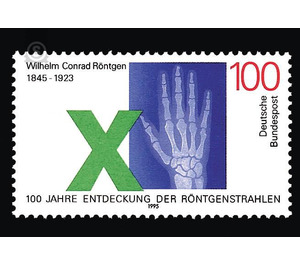150th birthday of Wilhelm Conrad Röntgen - Germany / Federal Republic of Germany 1995 - 100 Pfennig
Theme: Calender
| Country | Germany / Federal Republic of Germany |
| Issue Date | 1995 |
| Face Value | 100.00 |
| Color | white blue |
| Perforation | K 14 |
| Printing Type | Multicolor offset printing |
| Stamp Type | Postage stamp |
| Item Type | Stamp |
| Chronological Issue Number | 1657 |
| Chronological Chapter | GER-BRD |
| SID | 843241 |
| In 30 Wishlists | |
On the occasion of the 150th anniversary of the birth of Wilhelm Conrad Röntgen in March 1995 and the 100th anniversary of the discovery of the X-rays named after him, the Deutsche Bundespost is issuing a special stamp. Röntgen was born on March 27, 1845 in Lennep. After studying mechanical engineering and physics in Zurich, he followed his teacher August Kundt to Würzburg and Strasbourg, from where he was appointed to the Chair of Physics in Giessen in 1879. In 1888 he took over the chair of physics in Würzburg. There he dealt u. a. with the evacuated Geißler tube and pursued the goal of exploring the gas pressure-dependent phenomena in the passage of electricity. In these experiments, in the darkened room, X-ray observed the illumination of a paper screen painted with baryum platinum cyanurate on each discharge, and recognized that the fluorescence must emanate from the discharge apparatus. He called the cause, which can not be explained to him, a "new kind" of rays. He has researched their properties fundamentally in a few weeks. In 1896 he published two communications and a year later a third paper on the properties of these "X-rays." The discovery of X-rays was of great importance for physics, for mineralogy, for atomic structure research and light emission. On April 1, 1900 he took over the professorship for physics at the Ludwig-Maximilians-University Munich. In 1901 he was the first physicist to be awarded the Nobel Prize. In 1920 he retired. On February 10, 1923 W. C. Röntgen died in Munich.


